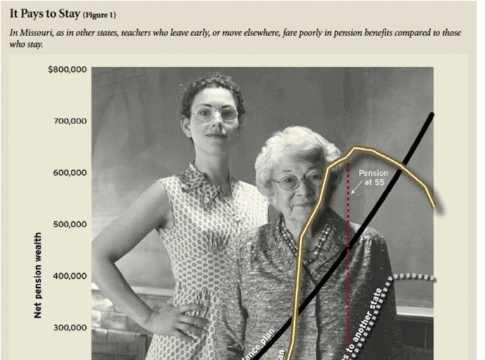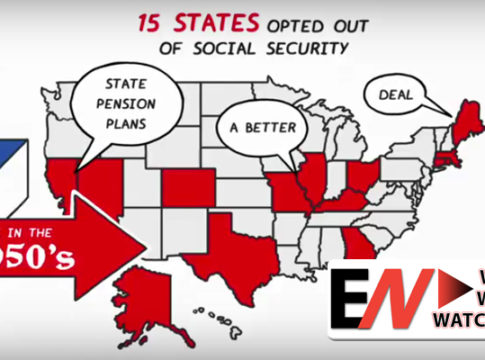An unabridged version of this article is available here.
The ongoing global financial crisis is forcing many employers, from General Motors to local general stores, to take a hard look at the costs of the compensation packages they offer employees. For public school systems, this will entail a consideration of fringe benefit costs, which in recent years have become an increasingly important component of teacher compensation. During the 2005–06 school year, the most recent year for which U.S. Department of Education data are available, the nation’s public schools spent $187 billion in salaries and $59 billion in benefits for instructional personnel. Total benefits added about 32 percent to salaries, up from 25 percent in 1999–2000. The increase reflects the well-known rise in health insurance costs, but it also appears to include growing costs of retirement benefits, which have received much less attention.
Conventional wisdom holds that teacher pensions (along with other public pensions) are more costly than private retirement benefits, for reasons dating to an earlier era of low teacher salaries over lifelong careers. In spite of dissent from this view by some researchers (see sidebar), in this case we find that conventional wisdom is right: the cost of retirement benefits for teachers is higher than for private-sector professionals.
| Wrong Data, Wrong Conclusion Our findings are at odds with the claim made by Lawrence Mishel and Richard Rothstein of the Economic Policy Institute in the June 2007 Phi Delta Kappan that employer contributions for retiree benefits for teachers are no higher than for professionals in the private sector. Their claim was also based on National Compensation Survey (NCS) data. The unabridged version of this paper provides a detailed critique of their methodology. The three main problems with their calculations are summarized below.
Inappropriate Occupational Categories The policy debate is about public school teachers, yet Mishel and Rothstein combine public and private school teachers in their analysis. In addition, the “professionals” to whom these teachers are compared also include all teachers; indeed, they are one of the largest components of this group. The authors mislabel the group in their article as “all other professionals,” but the Bureau of Labor Statistics (BLS) table from which their data are drawn clearly shows it to be an occupational grouping that includes teachers. Finally, while Mishel and Rothstein state that the appropriate comparison is with private-sector professionals, this group includes all state and local government professionals, too. The same BLS report provides separate tables with data for the two appropriate occupational groups: public school K–12 teachers and private-sector “management, professional, and related” workers. These are the tables we use in our analysis. Confounding Social Security Contributions Mishel and Rothstein are unable to isolate Social Security contributions with the table they use. In that table, Social Security contributions are subsumed into a larger category that also includes Medicare, worker’s compensation, and federal and state unemployment insurance. This problem does not exist when using the proper table for private-sector professionals, as Social Security contributions are separated out. The table with data for public school teachers does not separate out Social Security, but those contributions can be estimated using the NCS estimate for Social Security coverage, as explained in the text. Share of Total Compensation vs. Percentage of Earnings Mishel and Rothstein measure employer contributions as a share of total compensation instead of as a percentage of earnings. Shares of total compensation are not informative about how remunerative one occupation is compared to another. To take a simple example, suppose two occupations, one of them teachers, have identical earnings and retirement benefits, but differ in health insurance benefits. Since employer contributions to health insurance are markedly higher for teachers, the share of compensation for that component will be higher and the share for retirement will be lower, since all shares must sum to 100 percent. This fact alone mathematically reduces the share of total compensation that goes to retirement for public teachers, relative to private professionals. Summing Up Mishel and Rothstein find that employer costs for retirement constituted 11.5 percent of total compensation for “teachers” and for “other professionals” in June 2006. Correcting the three problems identified above, we find that employer contributions for retirement were 12.8 percent of earnings for public school teachers and 10.5 percent for private professionals in June 2006, a gap of about one-fifth. Since that time, as shown in Figure 1, contributions for private professionals have remained flat, while contributions for teachers have risen, doubling the gap between the two by September 2008. |
To track changes in retirement costs and compare employer contributions to retirement for public school teachers with those for private-sector professionals, we draw on recent data from a major employer survey conducted by the U.S. Department of Labor. These data show that the rate of employer contributions to retirement benefits for public school teachers in 2008 is substantially higher than for private professionals: 14.6 percent of earnings for teachers vs. 10.4 percent for private professionals. Moreover, the gap has widened over the four years the data have been available. Between March 2004 and September 2008, the difference more than doubled, rising from 1.9 to 4.2 percentage points (see Figure 1).

There are several reasons one might expect employer contributions to retirement to be higher for teachers. First, nearly all teachers are covered by traditional defined benefit (DB) pension plans, in which employees receive a regular retirement check based on a legislatively determined formula. These plans have, over the years, come to offer retirement at relatively young ages, at a rate that replaces a substantial portion of final salary. U.S. Department of Education data show a median retirement age for public school teachers of 58 years, compared to about 62 for the labor force as a whole. A teacher in her mid-50s who has worked for 30 years under a typical teacher pension plan will be entitled to an annuity at retirement of between 60 and 75 percent of her final salary. In nearly all plans this annuity has some sort of cost-of-living adjustment. One does not generally observe comparable retirement plans for professionals and lower-tier managers in the private sector, since most employers have replaced traditional DB plans with defined contribution (DC) or similar 401(k)-type plans, in which the employer and employee contribute to a retirement account that belongs to the employee. Nor do those traditional DB plans that remain typically reward retirement at such early ages; they more nearly resemble Social Security, where eligibility is age 62 for early retirement, and 66 and rising for normal retirement.
The Survey Data
Our analysis draws on data from the National Compensation Survey (NCS), an employer survey developed by the Bureau of Labor Statistics (BLS). The NCS survey is designed to measure employer costs for wages and salaries and fringe benefits across a wide range of occupations and industries in the public and private sectors. Although the BLS has been reporting quarterly fringe-benefit cost data for various public and private employee groups for more than a decade, only since March 2004 has the bureau broken out these fringe-benefit cost data for public school K–12 teachers. In this article we use those data to compare retirement benefit costs for public K–12 teachers with costs for private-sector professionals. We use the most detailed available private-sector comparison group, “management, professional, and related,” a category that includes business and financial managers, operations specialists, accountants and auditors, computer programmers and analysts, engineers, lawyers, physicians, and nurses.
We measure the cost of retirement benefits as a percentage of earnings. Virtually all states specify in law that the employer will contribute a certain percentage of teacher salaries to a DB pension fund (employee contributions are similarly specified), and it is commonplace to compare such contribution rates among the states. Similarly, private-sector employers offering DC plans will typically specify their contribution as a percentage of salary (often as a match to employee contributions). Unlike some other benefits (e.g., health insurance), if salaries change, the dollar costs for retirement benefits move proportionally. On the benefit side, the DB formula ties one’s starting annuity to final average salary, while the adequacy of a DC plan is commonly thought of in terms of the salary replacement rate. Thus it is natural to specify retirement costs as a percentage of salary, both for teachers and for private-sector professionals.
In making this comparison, we must account for the fact that, while all of the private-sector professionals are covered by Social Security, a number of public school teachers are not. Some of the higher cost of employer retirement plans for teachers is offset by lower employer contributions for Social Security benefits. Thus, we should compare the contribution rates for employer-provided retirement benefits and Social Security for both groups of workers. While the BLS reports the Social Security contribution rate for private professionals, it does not report a similar rate for teachers. However, we are able to make such an adjustment by multiplying the share of teachers covered by Social Security, which the BLS estimates to be 73 percent, times the employer contribution rate (6.2 percent). This assumes that the vast majority of teachers are below the Social Security earnings cap (currently $102,000) and that the share of teachers in Social Security has been steady over the four years for which we make the comparison.
A time series with quarterly data for these benefit percentages is reported in Figure 1. Two patterns are visible. First, the contribution rate is considerably higher for public school teachers than for private professionals. In the most recent quarter for which data are reported, ending September 2008, the employer contribution rate for public K–12 teachers (14.6 percent) was 4.2 points higher than that for private-sector professionals (10.4 percent). Second, the gap is widening. While the private sector contribution rate has been relatively flat over the four years, the rate for public school teachers has markedly increased, doubling the gap between them from one-fifth to two-fifths.
In one important respect, it is likely that the BLS data underestimate the cost of retirement benefits for public school teachers. Many public school districts (and some states) provide health insurance benefits for retired public school teachers. In the course of this research we were surprised to learn that retiree health insurance benefits are not included in the BLS employment cost estimates. Since private employers have largely eliminated this benefit, this means that our estimate of the gap in retirement benefits favoring public school teachers is low, although we cannot be sure of the extent of the underestimate.
Social Security and Teachers
While the overall employer contribution rate for public school teachers is higher than for private-sector professionals, the group average may mask differences between teachers who are and are not covered by Social Security. In order to assess this point empirically, we examined directly the data on employer contributions for teacher pension funds. We find that total employer contributions for both groups of public school teachers are higher than for private-sector professionals.
Most teachers are in statewide pension funds, with a relatively small number in district funds (e.g., New York City, Denver, St. Louis). Data on employer contributions for these plans are available in annual financial reports for each fund, which are surveyed by the National Association of State Retirement Administrators (NASRA).
Using data on contributions from NASRA and pension fund annual reports where necessary, and using weights based on the number of teachers employed in each state or district as reported in the NCES Common Core of Data, it is possible to compute average employer contribution rates for teachers. First we consider teachers who are in states and districts covered by Social Security. For these teachers, we calculate the weighted average employer contribution to be 9 percent of earnings. This can be compared to the estimate of employer contributions to retirement for private-sector professionals and managers, calculated from the BLS data as 4.7 percent for the comparable period (FY07). This is a 4.3 percent difference favoring public school teachers, almost double, in those states and districts where teachers are enrolled in Social Security, so the comparison is on an equal footing.

For states and districts where teachers are not in Social Security, we calculate the average employer contribution at 11.1 percent of earnings. Of course, this is considerably higher than the 4.7 percent retirement contributions for private-sector professionals, but, perhaps surprisingly, it even exceeds their employers’ combined contributions to retirement and Social Security, which averaged 10.3 percent for FY07. Thus, as Figure 2 shows, comparing teachers with professionals in private-sector employment, total employer contributions are higher for teachers whether or not they are also covered by Social Security.
Our analysis of evidence from the BLS National Compensation Survey and the NASRA Public Fund Survey shows that the employer contribution rates for public school teachers are a larger percentage of earnings than for private-sector professionals and managers, whether or not we take account of teacher coverage under Social Security. In addition, the BLS data show that the contribution rate for teachers is clearly trending upward.
Looking Ahead
What are the likely trends going forward for the cost of teacher retirement benefits? No one knows for sure, but we can identify the two key factors that will drive these costs: future developments in the benefits themselves and in their funding. The trend through much of the postwar period was to enhance the retirement formulas in various ways, including reducing the age or service requirement for full benefits. For example, just last year New York City agreed to enhance its pension formula for younger teachers. But there is evidence that benefit enhancement has generally abated in recent years. There are even a few states, including Texas, that have moved to reduce benefits for newly hired teachers. However, this is unlikely to reduce costs in the near future, since benefits for incumbent teachers are protected by law in most states.
The other factor to consider is the funding status of teacher pension plans. The vast majority of teacher pension plans are not fully funded. This means that contributions include both the “normal cost” of pension liabilities accruing to current employees and the legacy costs of amortizing unfunded liabilities accrued previously (due to a variety of reasons, including the original pay-as-you go nature of most plans, as well as unfunded benefit enhancements over the years). In theory, if the actuarial assumptions hold true going forward and no new benefits are enacted, the amortization costs will eventually disappear (after 30 years, under a typical funding schedule), in much the same way that a homeowner’s monthly expenses decline when the mortgage gets paid off.
However, the near-term prospects may be very different. For one thing, public pension funds face the possibility of important accounting changes. Unlike private pension funds, public fund actuaries have been allowed to discount future liabilities at a rate of about 8 percent, the assumed long-run market return on fund assets. Finance economists have argued that such a high discount rate is imprudent, however, and there have been signs that public accounting standards might move toward the private-sector rules, based on corporate bond and Treasury rates, which could reduce the discount rate to about 5 percent. This would dramatically raise the required amortization payments.
Finally, it bears noting that the market value of pension funds has fallen precipitously as of this writing (December 2008). Barring a major market recovery, pension funds across the country will have new, large unfunded liabilities. Under actuarial smoothing methods, these losses will be phased in, raising required amortization payments over the next few years. If the accounting rules for public funds also change, reducing the discount rate on liabilities, the employers of public school teachers, along with other public employers, will face a double hit, requiring sharp increases in contributions. By contrast, those private employers who have switched over to defined contribution plans in recent decades will be unaffected. In short, there are good reasons to believe that the contribution gap we have documented will continue to widen in coming years.
Robert M. Costrell is professor of education reform and economics at the University of Arkansas. Michael Podgursky is professor of economics at the University of Missouri–Columbia.





